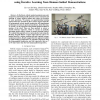Free Online Productivity Tools
i2Speak
i2Symbol
i2OCR
iTex2Img
iWeb2Print
iWeb2Shot
i2Type
iPdf2Split
iPdf2Merge
i2Bopomofo
i2Arabic
i2Style
i2Image
i2PDF
iLatex2Rtf
Sci2ools
ICRA
2010
IEEE
2010
IEEE
Superhuman performance of surgical tasks by robots using iterative learning from human-guided demonstrations
In the future, robotic surgical assistants may assist surgeons by performing specific subtasks such as retraction and suturing to reduce surgeon tedium and reduce the duration of some operations. We propose an apprenticeship learning approach that has potential to allow robotic surgical assistants to autonomously execute specific trajectories with superhuman performance in terms of speed and smoothness. In the first step, we record a set of trajectories using human-guided backdriven motions of the robot. These are then analyzed to extract a smooth reference trajectory, which we execute at gradually increasing speeds using a variant of iterative learning control. We evaluate this approach on two representative tasks using the Berkeley Surgical Robots: a figure eight trajectory and a two handed knot-tie, a tedious suturing sub-task required in many surgical procedures. Results suggest that the approach enables (i) rapid learning of trajectories, (ii) smoother trajectories than the human-...
| Added | 13 Feb 2011 |
| Updated | 13 Feb 2011 |
| Type | Journal |
| Year | 2010 |
| Where | ICRA |
| Authors | Jur van den Berg, Stephen Miller, Daniel Duckworth, Humphrey Hu, Andrew Wan, Xiao-Yu Fu, Ken Goldberg, Pieter Abbeel |
Comments (0)

